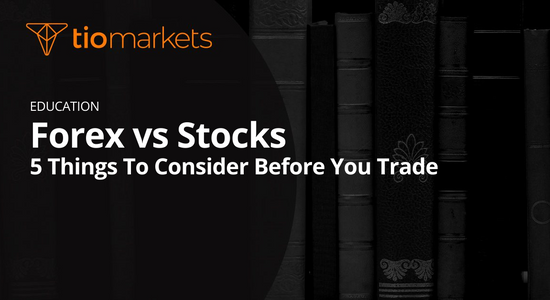Risk disclaimer: CFDs are complex instruments and come with a high risk of losing money rapidly due to leverage. 80% of retail investor accounts lose money when trading CFDs with this provider.
You should consider whether you understand how CFDs work, and whether you can afford to take the high risk of losing your money. Professional clients can lose more than they deposit. All trading involves risk.
MetaTrader 4 Versus MetaTrader 5: Which Platform Is Right For You?
BY TIO Staff
|January 3, 2022For forex and CFDs traders of any experience level looking for a top-of-the-line trading platform with a great range of features, you simply can’t ignore the two most popular platforms used by traders worldwide, MetaTrader 4 and MetaTrader 5. However, deciding on which is suitable for your needs is an important step to give you the best chance for success when trading the markets.
In this article, we’ll give you a clear picture of the differences, as well as the similarities between the two, and offer all the information you need to make an informed decision on which platform is right for you and your trading goals.
What Are The MetaQuotes Platforms?
MetaTrader 4 and MetaTrader 5, commonly referred to as MT4 and MT5, are platforms developed by MetaQuotes that can be downloaded to your computer or mobile device. Through the platform, you’ll be able to view the instruments on offer for each platform, analyse the markets using charts, objects and technical indicators, and place all types of orders such as market orders and limit orders. The platforms will also let you monitor and manage your orders and view your position history.
Why Are MT4 And MT5 So Popular?
Several factors have propelled MT4 and MT5 to become the world’s most widely-used trading platforms. Perhaps their single most popular attribute is their wide range of technical analysis tools, such as indicators and chart objects. In particular, traders who rely on studying price action via charts tend to prefer these two platforms.
In addition to technical traders, the platforms have become hugely popular with those seeking to take advantage of trading robots, called Expert Advisors, which execute trades on the platform automatically, based on a predefined set of rules. This lets traders capitalise on market moves without any human effort, and they are used by both beginner and advanced traders. The MT4 and MT5 communities even have large marketplaces where users can search for and purchase expert advisors that work on each platform. Many of these are also available for free.
For these primary reasons, MT4 and MT5 are especially popular amongst intermediate and advanced traders.
Instruments on MT4 and MT5
On the TIOmarkets platforms, there is an important difference between the instruments offered on MT4 and those on MT5. MetaTrader 4 was designed specifically for forex CFDs in mind, whereas MetaTrader 5 was designed with far more CFD asset classes in mind. Whereas on MT5 our clients will also gain access to stocks, indices and, depending on your jurisdiction, crypto assets.
MT4 remains the more popular platform with users looking to trade only traditional forex instruments. That’s because it is the original platform, has been around for years longer than MT5, and therefore has more to offer in terms of expert advisors and a larger online community. MT4 also has fewer tools on offer than MT5, which makes it more popular amongst new traders who don’t need such a wide array of tools or timeframes.
MT5 on the other hand is gaining in popularity, especially with traders looking to diversify or expand their trading outside of traditional forex instruments.
Chart Time Frames
Chart time frames refer to the length of time for each period shown on the chart. For most people, this would mean the time allocated to each candlestick. For example, a time frame of 1 hour means that each candlestick will show the open, close, high and low price for one hour of time.
MT4 offers a range of nine different time frames, ranging from 1 minute to 1 month. MT5 expands this selection to 21-time frames, to cater to more advanced traders who may need a wider range of times to execute their trading style. MT5 includes 2, 3 and 4-minute charts, as well as 2, 3 and 6 hour charts, none of which are available on MT4.
MT4 Vs MT5 – Which Is More User Friendly?
In terms of the interface, both MT4 and MT5 look and feel almost identical. While there are more under-the-skin features in MT5, it would be hard to distinguish many differences between the platforms at first glance.
Traders might notice that relative to other trading platforms that are focused on entry-level traders, the MetaQuotes platforms look relatively complex by comparison. This is because the platforms are in fact targeted at more experienced traders. However, it should be said that new traders shouldn’t be put off by the optics of these platforms, as they are both relatively simple to use once you know where to look, even for traders who just want the basics of trading.
Both platforms are very user-friendly for any level of trader.
Which Platform Has More Technical Indicators, MT4 or MT5?
This is a noticeable area of difference between the two platforms. MT5 has eight more technical indicators than MT4 when it is first downloaded, with 38 compared to MT4’s 30.
Having said that, advanced traders who use a wide array of technical indicators for their analysis will still tend to choose MT4 over MT5. That’s because the community has spent more years developing custom indicators for MT4, which can be easily added to the platform.
More than 1,300 additional indicators exist in the MT4 marketplace for free, with more than 5,000 others available for purchase. This is approximately twice as many as in the marketplace for MT5.
Pricing for these indicators is set by the developer, and the cost of an indicator will vary. The low-cost indicators will usually come in at between 30 and 100 USD, while the higher-cost indicators can be priced at hundreds of US dollars.
Charting Tools & Objects In MT4 & MT5
Both platforms are designed for heavy technical analysis and charting, and as such both come with most analysis tools a trader would hope to find, such as lines, shapes and measuring tools. However, MT5 goes a step further than MT4 in this respect, offering 44 chart objects compared to MT4’s 24.
Both platforms let you open as many charts as you wish to at once, so you can view your markets across multiple screens.
Order Types
The older MT4 platform offers five order types, which is more than sufficient for most traders, even intermediate level traders. The order types are market orders, and “limit order” types which include buy-stop, buy-limit, sell-stop and sell-limit orders. Market orders are for entering your trades immediately, while the limit order options are for placing future trades depending on whether or not the price reaches the desired level that you set.
MT5 offers all of these order types along with an extra two: “buy stop-limit” and “sell stop-limit”. These order types combine the features of the buy/sell stop and buy/sell limit orders. While regular limit orders are executed once the price you set is reached, these new order types will place a new limit order once the price condition is met, meaning that you can go an extra step into future price action.
MQL4 vs MQL5
The programming language used to build custom indicators and expert advisors for MT4 and MT5 is arguably the greatest difference between these two platforms. MT4 uses MQL4, while MT5 uses MQL5. This has been a point of great contention since the release of MT5 for several reasons.
Technically, MQL5 is far more advanced than MQL4. It’s based on C++, which is a popular programming language for financial applications. In theory, it takes far less time to write and produce indicators or robots on MT5 compared to MT4.
One point of contention is that MQL5 is not “backwards compatible” with MQL4, meaning that any custom indicators built for MT4 will not work on MT5, and vice versa. This has meant that developers who spent many years creating programmes for MT4, had to recreate those programmes for MT5 using a completely different language if they wanted to make it available on both platforms. It also meant that MT4 traders who wanted to transfer their programmes to MT5 were not able to do so. However, there remains a thriving community of development for both languages, and plenty of indicators and trading robots can be found for each platform.
MQL5 is also the main factor that allows MT5 to be superior to MT4 when it comes to backtesting strategies and robots.
Backtesting Expert Advisors
Each platform has backtesting capabilities, which lets you test how your expert advisor would have performed against historical market data. MT5 improves on MT4’s backtesting in one crucial way. It is multi-threaded, while MT4 is single-threaded. This essentially means that with MT5, users can backtest strategies for multiple symbols at once, while MT4 is only capable of handling one test for a single instrument at a time. This means that for traders who would like to run their strategy on different symbols simultaneously, MT5 is clearly the way to go as it will save you lots of time when testing.
In addition, MT5 lets you save results as an HTML file, which you can open from your browser, or as a .csv file which you can open in Excel or any other spreadsheet tool. MT4 only supports HTML file exports.
Platform Speed
Both platforms are extremely fast and can run on most machines without any difficulty. However, when looking at the technical specifications, MT5 is clearly a faster platform than MT4.
For starters, MT5 is built for 64-bit processors and operating systems, while MT4 was built when computer processors were considerably slower. As such, MT5 will perform faster than MT4 and is less likely to noticeably slow your computer down when it’s running on a suitable machine. Although MT4 can be run on a 64-bit operating system, it will perform slower than when it’s running in the environment it was built for.
MT5 meanwhile can be used in a 32-bit environment provided your machine has at least 4GB of RAM.
For traders with a low-spec machine, it’s recommended that they opt for the MT4 platform in order to have a smooth trading experience.
It should be noted that the platform speed does not impact the execution speed. Execution times on MT4 and MT5 may vary very slightly, but this isn’t down to the technical specifications of the platforms. On TIOmarkets platforms, we offer some of the best execution speeds in the market, meaning your order entry on both MT4 and MT5 will be impeccable.
Conclusion
These two popular platforms have their similarities and their differences. In many critical areas, the platforms are virtually identical. They’re both fast, both offer a good array of indicators and tools right out of the box, and both are suitable for automated trading via expert advisors.
If you know that you’d like to trade stocks or other CFDs that aren’t available on MT4, then the decision becomes quite easy – MT5 is the best option for users who want to trade a wider variety of instruments and asset classes. If you’re into technical analysis via your own drawings on the chart, but not as deep into indicators, then we would also recommend that you choose MT5 as your main platform. That’s because it has considerably more chart objects than MT4.
On the other hand, if you only want to trade forex, and if you want a wider range of marketplace indicators and robots to choose from for forex trading, then MT4 is your best bet, as there are simply more options available for you to choose from.
Demo Account
The best way to get to know the differences between MT4 and MT5 is to download a demo of each and have a look around for yourself. You can download a free demo of each platform if you register for an account, with no obligation to deposit or trade.
You’ll receive your login details once you verify your email, and you can download the TIOmarkets MT4 and MT5 platforms when you log in to the client area. Have a look at the time frames, objects, indicators, and instruments list, and see which platform you think would better suit your needs.
Risk warning: CFDs are complex instruments and come with a high risk of losing money rapidly due to leverage. 62% of retail investor accounts lose money when trading CFDs with this provider. You should consider whether you understand how CFDs work, and whether you can afford to take the high risk of losing your money. Professional clients can lose more than they deposit. All trading involves risk.

Related Posts



